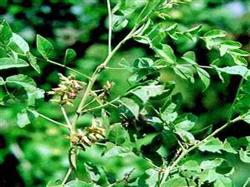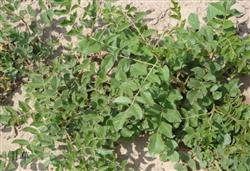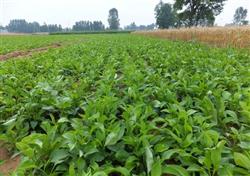Technical specification for ridge and furrow cultivation of licorice covered with plastic film

1. The scope of selection. Licorice has strong adaptability and can grow in general soil, but the slightly alkaline or alkaline sandy loam with a pH value of 7.2 Murray 8.5 is the most suitable. 2. Stubble selection. Licorice belongs to Leguminosae Glycyrrhiza belongs to perennial herbs, the previous crop is better than Gramineae crops, do not choose legumes. 3. Soil preparation and fertilization. After the previous crop harvest, combined with deep ploughing and soil preparation, apply high-quality farm manure 3500 Mu 4000 kg, phosphate fertilizer 50 kg, rake fine leveling to preserve soil moisture, in preparation for planting. 4. Timely planting. In the middle and late April, in the whole plot, a trench with a depth of 15cm was opened according to the row spacing of 20cm, and the seedlings were slightly tilted upward into the ditch according to the plant spacing of 30cm in the shape of "taste". Then cover the front row of seedlings with trenched soil and rake fine, according to this three small trenches as a group, compacted with plastic film with a width of 80cm, so that it formed a "three-ridge trench" cultivation model, planting about 10,000 plants per mu. 5. Field management. After planting seedlings, it is necessary to carefully tear open the plastic film and release the seedlings in time to prevent burning the seedlings, and press the torn place of the plastic film with sandy loam soil. Artificial cultivation of licorice must keep the soil layer around the Reed head soft and make the weak buds exposed to the ground to grow into new main branches. Combined with ploughing and weeding, it was found that the underground transverse stem should be removed in time to promote the growth of main root and improve the proportion of grade grass. 6. pest control 6.1 rust. The initial stage of the disease was sprayed with 1000 times solution of 70% trimethoprim. 6.2 powdery mildew. 50% methyl topiramate can be sprayed with 100 times liquid. 6.3 Gray spot. You can use 75% chlorothalonil wettable powder 500 Murray 600 times liquid spray. 6.4 insect pests. It can be controlled by 90% trichlorfon or 40% dimethoate root irrigation. 7. Harvest. The grade grass standard can be reached after 3 years of growth, and the best excavation season is when the leaves turn yellow in autumn. The method is to first cut off the stems and leaves, remove the plastic film, dig deeply along both sides, pull it out when the rhizome is exposed to more than 40 centimeters of the ground, shake the soil, remove the Reed head, root and tail, and lateral roots, and then go on the market after being dried in different grades.
- Prev

Harvest and processing of licorice
The key technical measures of high-yield cultivation were to plant in sandy loam soil with fertile soil, loose texture and good drainage. The seeds are treated before sowing to improve germination rate, watered at seedling stage to protect seedlings, and applied with sufficient phosphorus and potassium fertilizer in early spring every year. Harvesting and processing 1. Harvesting licorice propagated with seeds generally grows after sowing 4.
- Next

Planting technique of traditional Chinese Medicine Atractylodes macrocephala Koidz
Cultivation techniques 1. Seedling (1) A month before sowing, Atractylodes macrocephala Koidz turned over the soil, covered with weeds 30 cm thick, burned the soil and disinfected it to prevent diseases and insect pests. After burning, turn the grass ash into the soil. If the soil is not burned, it can be turned over in the winter of the first year so that the soil can be fully weathered by freezing. Land.
Related
- Fuxing push coffee new agricultural production and marketing class: lack of small-scale processing plants
- Jujube rice field leisure farm deep ploughing Yilan for five years to create a space for organic food and play
- Nongyu Farm-A trial of organic papaya for brave women with advanced technology
- Four points for attention in the prevention and control of diseases and insect pests of edible fungi
- How to add nutrient solution to Edible Fungi
- Is there any good way to control edible fungus mites?
- Open Inoculation Technology of Edible Fungi
- Is there any clever way to use fertilizer for edible fungus in winter?
- What agents are used to kill the pathogens of edible fungi in the mushroom shed?
- Rapid drying of Edible Fungi

